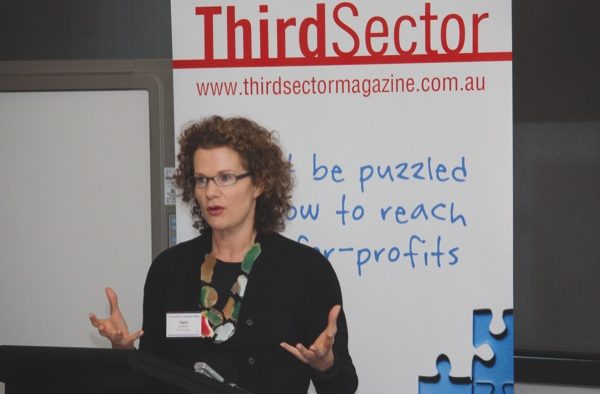Philanthropy as financial empowerment
There is an enormous amount of influence that women can exert through taking leadership in their philanthropic activities. However, Australia’s women are yet to seize this power or demonstrate leadership in the context of philanthropic giving.
I came to this ‘aha’ moment when I went to a recent ‘women in philanthropy’ conference in the United States.
This absence of female leadership in Australia’s philanthropic community was brought into sharp relief by the overwhelming sense of empowerment that was demonstrated by American women at this conference.
The contrast between American and Australian women exists in an incredible feeling of strategic and financial empowerment that American women demonstrate through the very strategic way in which they make their philanthropic investments.
These women don’t have to be particularly wealthy, but through their philanthropic initiatives, they are really making a difference.
With the exception of a rare number of individuals, there is little evidence of Australia’s women taking a big, bold initiative in the context of philanthropic giving. Australian women are not independently striving to embrace the creation of large-scale strategic and ambitious contributions. Instead, there is a reliance on the men of mining, finance, IT, advertising and media, to headline all of these major third sector initiatives.
Women’s involvement in more medium-scale funding opportunities is also under-represented. Although there is significant potential for women to play a leading role in this sector, they are not positioning themselves as significant players at the forefront of third sector investing.
In order for women to successfully move into leadership roles in Australia’s philanthropic community, they must firstly create an image of themselves as philanthropists in their own right.
Learning about effective philanthropic giving is an important part of re-situating women in the image of the philanthropist. Women can utilise professionals such as lawyers, advisors and accountants to help them structure a ‘giving framework’ that is affordable within their personal circumstances.
The movement of women into leadership positions has the potential to re-shape the nature of philanthropic activity in Australia.
Applying the gender-lens to philanthropy
Did you know that in the United States only 20 cents in every philanthropic dollar goes to women and girls? The question is rarely asked “If I give $100 to this particular group or cause, are women and girls going to benefit from that contribution as much as men and boys?”
A new initiative called the Australian Women Donors Network is working to create an awareness around ‘gender-lens philanthropy’. This concept is very new and very crucial. The goal is to embed a ‘gender-lens’ so that when a foundation supports a community organisation, one of the questions that they will be asking is “will this contribution benefit women and girls in the same way that it benefits men and boys?”
Screening as financial empowerment
Women as philanthropists also have the ability to both positively and negatively screen the organisations that they are investing in. For example, women can choose not to invest in a particular company because of its association with the gambling or tobacco industries, and this choice is an exercise of financial power. The next and most crucial step in the screening process is to talk about it.
Women must talk about what they will support and what we won’t support in a commercial context.
Until the large corporates and chairmen of boards understand that women can actually influence the financial outcomes and the financial results of their companies, as well as the corporate reputation of these companies, women will be absent from the execution of corporate power.
Women can also choose to finance women in politics. In the US, for example, one particular female philanthropist is organising 500 women to invest in female candidates who are pro-choice, regardless of which party they are standing for.
In Australia, the success of Prime Minister Julia Gillard and other senior politicians in the Australian Labor Party has been fostered through the efforts of Emily’s List – a not-for-profit organisation helping women in the Labor Party move into Australia’s parliaments.
The power of women in politics cannot be underestimated. Research has shown that in Australia’s political context women need to achieve a 30 per cent rate of representation in state and federal parliaments before they will be able to achieve any influence on legislative agendas.
Women incorporated
There has been little change in the level of women in corporate leadership positions over the last 25 years, despite the incredible effort made by people such as Australia’s Sex Discrimination Commissioner Elizabeth Broderick.
In response to the immense gap, I have registered an organisation called the Women’s Leadership Institute Australia, which will work with existing organisations to make sure that the work they’re doing in the area of women’s leadership actually has a sustained effect, and that the research about women in leadership is actually activated and stays on the corporate and political agenda.
The Institute will also team up with Chief Executive Women, a network of 80 very senior female corporate executives, and give scholarships to women on the leadership trajectory to go Harvard University and complete a course called “A Leadership Forum for Women”.
The Institute is also aiming to achieve a fair representation of women in Australia’s honour system, which currently stands at approximately 20 per cent. It will create awareness that, compared to men, so few women are being nominated for the Australian honours, despite the amazing amount of work they do in the community sector.
Moving to the ‘for-purpose’ sector
The description ‘not-for-profit’ is a re-hashing of the old saying “I make the money and she spends it”. These are for-purpose organisations. Why attach a negative?
There is a tremendous need to move away from the old language of charities and not-for-profits, and the old-fashioned connotations of these terms. We have the potential to fashion a new language to encapsulate the essence of ‘for-purpose’ organisations. We’re not giving charity, we’re all investing in a better community and community organisations that have a real purpose.
Women represent approximately 70 per cent of third sector employees. They are the powerhouse of activity and have sustained the sector for decades with extraordinary benefits to communities.
However, there is a huge contrast of under-representation of women in leadership positions for the large-scale non-profit organisations.
From a list of the top 50 fundraising organisations (those which raised over $12 million from fundraising activities in the 2007-08 financial year – as published by GiveWorld in 2009), only 26 per cent of CEOs in these organisations are female.
Out of the 227 executives that support the CEOs, only 33 per cent are female. The same trend is reflected in the boardroom, with only 31 per cent of directors in the organisations being female, and only 24 per cent of the boards being chaired by a woman.
Women represent only ten per cent of the chairmen. Of the organisations that have over $100 million in net assets, and there are currently eleven of these, there is only one female chairman.
The result is that fewer women are in positions which allow them to exercise real power in important decision-making processes.
A way forward
There are a number of small actions women can take to begin changing the leadership landscape in Australia.
If you are asked to recommend somebody, think of woman first.
Be a part of the discourse on the reality of today’s opportunities for women in leadership by exercising financial empowerment.
Financial empowerment is about feeling that you’ve got a voice and that you can express an opinion that is going to affect a commercial outcome for an organisation that really wants you onside.
If we can embed a gender-lens awareness in every foundation and in every philanthropist, then we will have done our job.


























































































































































